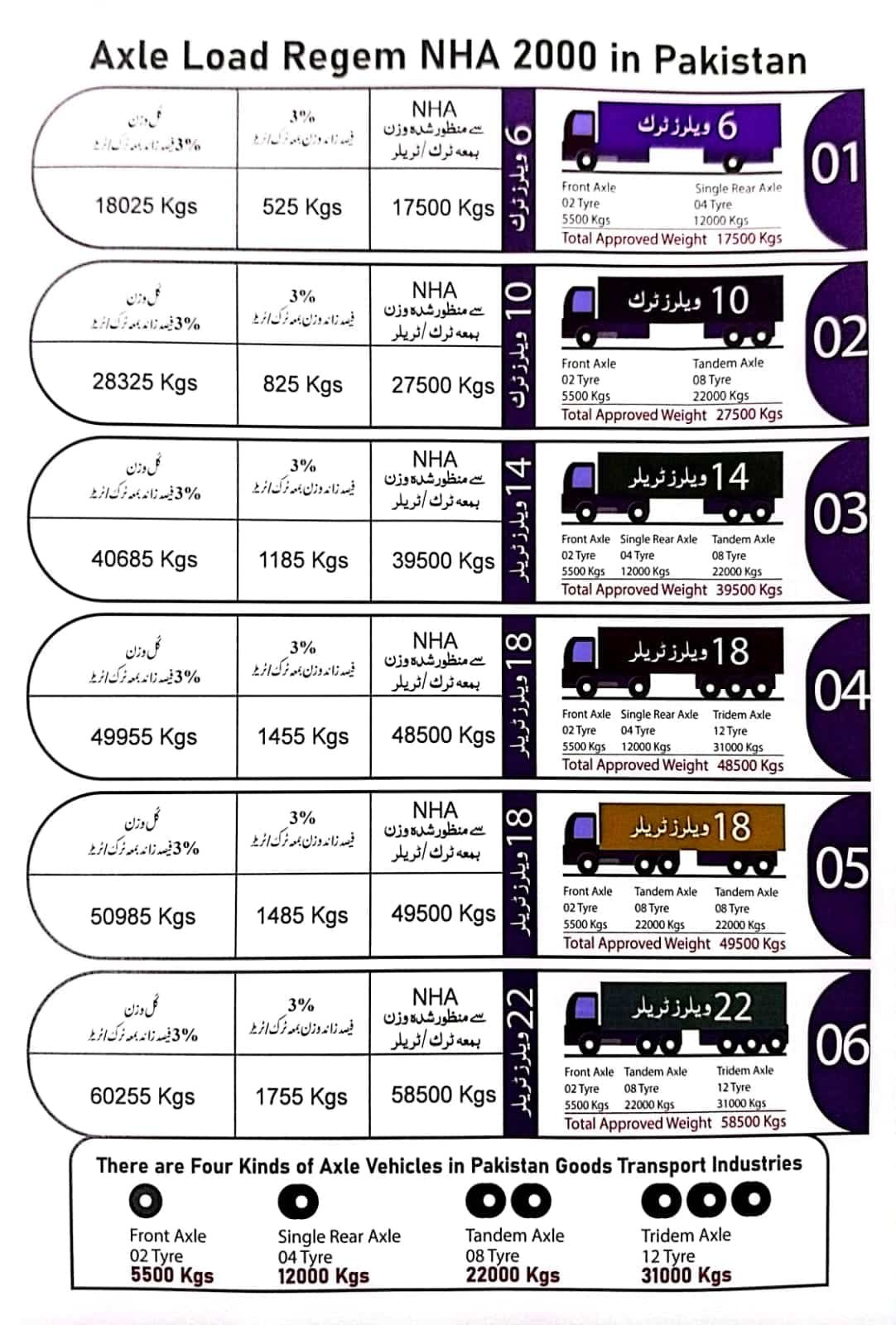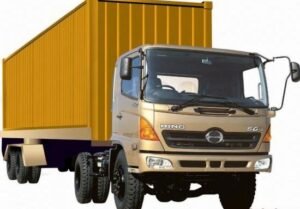
Introduction
Pakistan’s road transport sector relies on axle load regulations to ensure safe and efficient goods transportat
ion. The National Highway Authority (NHA) 2000 regulations define weight limits for different truck types to protect roads, improve safety, and reduce maintenance costs.
This guide provides details about approved weight limits, empty vehicle weight, and goods carrying capacity for various trucks used in Pakistan.
Axle Load Limits for Different Truck Types
Below are the NHA-approved weight limits, including empty vehicle weight and maximum cargo capacity:

- Front Axle (2 Tyres): 5,500 kg
- Single Rear Axle (4 Tyres): 12,000 kg
- Empty Vehicle Weight: 7,500 kg
- Goods Capacity: 10,000 kg
- Total Approved Weight: 17,500 kg

2. 10-Wheeler Truck
- Front Axle (2 Tyres): 5,500 kg
- Tandem Axle (8 Tyres): 22,000 kg
- Empty Vehicle Weight: 10,500 kg
- Goods Capacity: 17,000 kg
- Total Approved Weight: 27,500 kg

3. 14-Wheeler Truck
- Front Axle (2 Tyres): 5,500 kg
- Single Rear Axle (4 Tyres): 12,000 kg
- Tandem Axle (8 Tyres): 22,000 kg
- Empty Vehicle Weight: 13,000 kg
- Goods Capacity: 26,500 kg
- Total Approved Weight: 39,500 kg

4. 18-Wheeler Truck (Tridem Axle)
- Front Axle (2 Tyres): 5,500 kg
- Single Rear Axle (4 Tyres): 12,000 kg
- Tridem Axle (12 Tyres): 31,000 kg
- Empty Vehicle Weight: 16,500 kg
- Goods Capacity: 32,000 kg
- Total Approved Weight: 48,500 kg

5. 18-Wheeler Truck (Two Tandem Axles)
- Front Axle (2 Tyres): 5,500 kg
- Tandem Axle (8 Tyres): 22,000 kg
- Tandem Axle (8 Tyres): 22,000 kg
- Empty Vehicle Weight: 16,500 kg
- Goods Capacity: 33,000 kg
- Total Approved Weight: 49,500 kg

6. 22-Wheeler Truck
- Front Axle (2 Tyres): 5,500 kg
- Tandem Axle (8 Tyres): 22,000 kg
- Tridem Axle (12 Tyres): 31,000 kg
- Empty Vehicle Weight: 19,500 kg
- Goods Capacity: 39,000 kg
- Total Approved Weight: 58,500 kg
Importance of Following Axle Load Limits
Enforcing axle load regulations benefits transporters, road authorities, and the general public. Here’s why compliance is essential:
✅ Prevents Road Damage – Overloaded trucks cause potholes and structural damage, leading to costly repairs.
✅ Improves Road Safety – Proper weight distribution reduces braking distances and prevents accidents.
✅ Reduces Maintenance Costs – Trucks carrying legal weight limits experience less wear and tear, lowering repair expenses.
✅ Avoids Heavy Fines – Exceeding weight limits can result in penalties, legal action, and vehicle impoundment.
Types of Axles in Pakistan’s Goods Transport Industry
Pakistan’s transport industry commonly uses the following axle types:
- Front Axle (2 Tyres) – 5,500 kg capacity
- Single Rear Axle (4 Tyres) – 12,000 kg capacity
- Tandem Axle (8 Tyres) – 22,000 kg capacity
- Tridem Axle (12 Tyres) – 31,000 kg capacity
Best Practices for Transporters
To operate efficiently and avoid legal issues, follow these best practices:
🚛 Weigh Your Truck Before Traveling – Always check the load before hitting the road.
🚛 Balance the Load Properly – Uneven weight distribution can cause instability and tire damage.
🚛 Use the Right Truck for the Job – Choosing the correct truck type ensures smooth and legal transport.
🚛 Maintain Proper Tire Pressure – Under-inflated tires increase fuel consumption and wear out faster.
🚛 Educate Drivers on Load Regulations – Awareness and compliance help avoid fines and maintain road safety.
Conclusion
Adhering to NHA 2000 axle load regulations ensures safer roads, lower costs, and legal compliance for transporters. By following the approved weight limits, truck owners and logistics companies can improve efficiency and extend the lifespan of their vehicles.
For more transport industry updates, stay connected with us! 🚛✨




